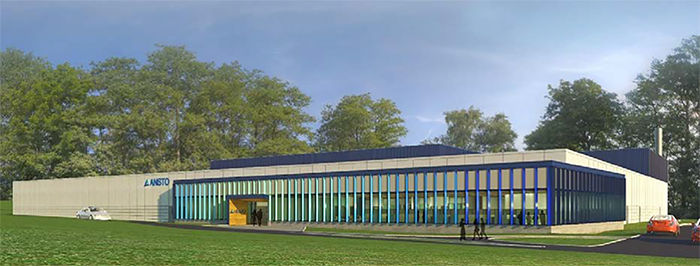 The Australian Nuclear Science & Technology Organisation (ANSTO) has welcomed a federal government funding allocation intended to support nuclear medicine development. During a visit to ANSTO’s Lucas Heights campus near Sidney, Minister for Industry & Science Ed Husic outlined plans for a new Nuclear Medicine Facility to replace ANSTO’s ageing Nuclear Medicine Processing & Distribution Facility, which was built in 1959 as a research laboratory, also known as Building 23.
The Australian Nuclear Science & Technology Organisation (ANSTO) has welcomed a federal government funding allocation intended to support nuclear medicine development. During a visit to ANSTO’s Lucas Heights campus near Sidney, Minister for Industry & Science Ed Husic outlined plans for a new Nuclear Medicine Facility to replace ANSTO’s ageing Nuclear Medicine Processing & Distribution Facility, which was built in 1959 as a research laboratory, also known as Building 23.
Since the late 1970s, ANSTO has produced a range of nuclear medicines and currently supplies around 75-80% of the nuclear medicine used in Australia. This includes production of molybdenum-99 (Mo-99), which is dispatched into ANSTO’s Gentech Generators, where it decays to become technetium-99 (Tc-99m), the most widely-used radioisotope in nuclear medicine.
ANSTO’s Lucas Heights nuclear medicine precinct hosts three key facilities: the OPAL multipurpose research reactor, the Molybdenum-99 Manufacturing Facility, and the Nuclear Medicine Processing & Distribution Facility. In January 2007, following nearly 50 years of operation, HIFAR was shut down. Four months later, the $300m OPAL reactor was officially opened by then prime minister John Howard. Radioisotopes are produced by the reactor through a fission process. OPAL is estimated to have a 60-plus years design life.
Among the radioisotopes produced is Mo-99. The irradiated target plates are then sent to the nearby and newly constructed Mo-99 Manufacturing facility, Building 88, where they are dissolved in shielded hot cells. This work was previously conducted in the older Building 54 which closed in 2019. Once the Mo-99 has been extracted and purified in Building 88, it goes to Building 23 where it is dispensed into the Gentech Generators.
In recent years, Building 23 has been the focus of safety concerns and technical problems. In 2017 a technician dropped a vial containing radioactive material. His hands were contaminated through two pairs of gloves, exposing him to health risks. Three less-serious incidents followed a 2018 independent report found the precinct failed to meet modern nuclear safety standards. In 2019, a mechanical failure at Building 23 led to a major disruption of domestic supply of Mo-99.
According to the 2018 report a key cause of the problems was federal government budget restrictions that had delayed plans to decommission and replace Building 23. However, funds for the upgrade may now be forthcoming. According to the latest federal budget, the government announced “funding over 10 years from 2023-24 to construct a new nuclear medicine manufacturing building, as well as ongoing maintenance of the current ageing facility”. The budget did not disclose how much funding had been allocated, citing “commercial sensitivities”. Construction of the new facility is expected to take more than 10 years.
Industry Minister Husic said he could not discuss the project's cost as it had been put out for commercial tender. "We're not building something that's just a shed in the middle of a paddock, so people can appreciate that it's going to be a bit complex," he told Sydney radio 2GB. The former coalition government in 2021 announced AUD30m ($12.8m) in funding to upgrade the Building 23 site but the sum involved is expected to be more than this.
Image: Artist's impression of the new facility at ANSTO's Lucas Heights campus (courtesy of ANSTO)



